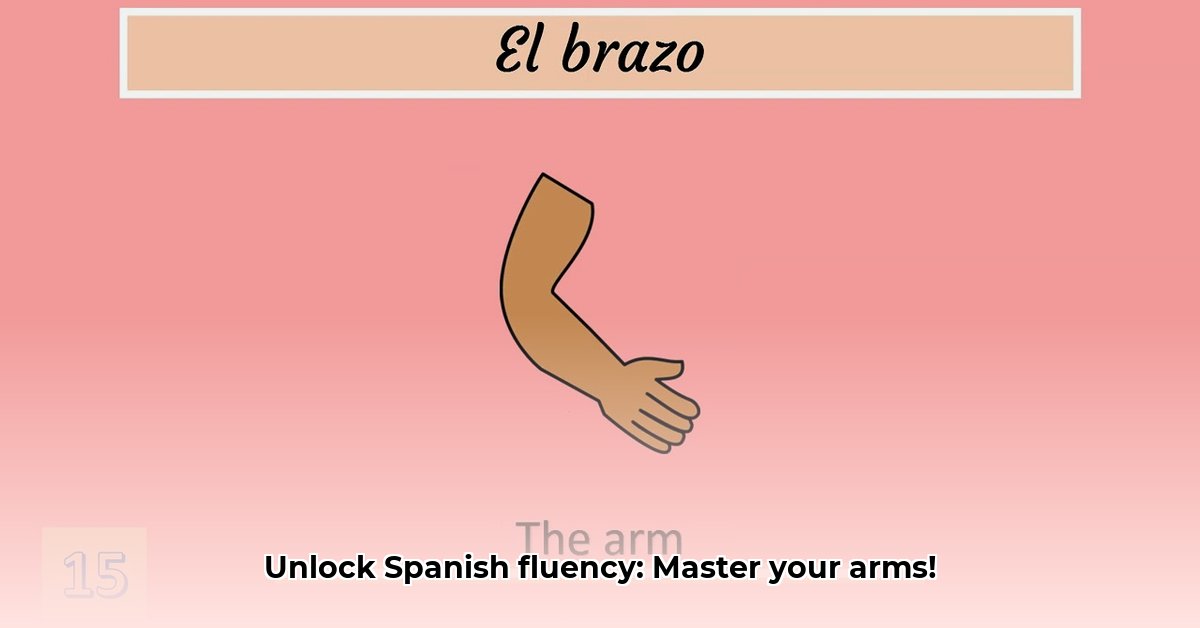“`markdown
Mastering Arms in Spanish: The Ultimate Guide
Ever pondered the multitude of ways to express “arm” in Spanish? The intricacies extend beyond a simple translation. This article delves into the diverse meanings of “arm,” illuminating how these nuances influence the ideal Spanish word choice. From anatomical references to weaponry and figurative expressions, we navigate the complexities. We will explore common translation errors and provide practical advice for selecting the perfect Spanish equivalent, catering to translators, language learners, and anyone intrigued by the subtleties of language. This guide provides a comprehensive understanding of the various meanings of the word “arm” and how to translate them accurately into Spanish.
Arms in Spanish: A Translator’s Guide
Let’s explore translating the English word “arm” into Spanish, a task more nuanced than it appears. This guide breaks down the various meanings of “arm” and offers guidance on selecting the most appropriate Spanish translation for each context, which could include brazo, arma, manga, rama, and more. Understanding these nuances is key to effective communication and translation.
The Body Part: More Than Just “Brazo”
When referring to a human limb, “brazo” serves as the straightforward translation for “arm.” However, even in this seemingly simple case, context remains paramount. In a medical report detailing a fractured limb, for instance, using only “brazo” might lack the necessary precision. Employing phrases like “hueso del brazo” (arm bone) or specifying “brazo derecho” (right arm) or “brazo izquierdo” (left arm) can provide increased clarity in such instances. This illustrates how even a seemingly simple word can possess complexities depending on its specific application. Consider also the phrase “brazos cruzados” for “arms crossed,” indicating a posture or attitude. The human arm consists of several parts, including the húmero (humerus), cúbito (ulna), and radio (radius). Knowing these terms can be vital in technical or medical contexts.
Weapons: It’s All About “Arma”
When referring to weapons, the Spanish equivalent is “arma” (singular) or “armas” (plural), a relatively uncomplicated translation. However, consider the scenario: are we describing a delicate dagger or a heavy machine gun? The specific type of weapon can influence the most appropriate terminology. An assault rifle, for example, might warrant more specific terminology such as “fusil de asalto” rather than simply “arma.” Furthermore, the collective term “armamento” refers to weaponry in general. The level of detail required depends entirely on the context, demonstrating how choosing the right Spanish word can add both precision and color to your translation. Weapon can be translated to arma, Firearms can be translated to armas de fuego, and Bladed weapons can be translated to armas blancas.
Beyond the Physical: Figurative Meanings Abound
The word “arm” transcends the limitations of anatomy. Consider the armrest of a chair – again, “brazo” is a generally acceptable translation, although “apoyabrazos” is more specific. But what about the sleeve of a piece of clothing? In this case, “manga” would be more suitable. And let’s not forget the “arms” of a river. This meaning is more figurative, often referring to a river’s branches or tributaries. You might use “rama” (branch), “cauce” (channel), “brazo” (arm), or even “confluencia” (confluence), all depending on the specific aspect you wish to emphasize. For example, “el brazo del río Amazonas” refers to a specific branch of the Amazon River. This highlights how meaning is heavily reliant on context.
Idioms: A Translator’s Playground
This is where things get truly engaging and challenging. Idioms are phrases whose literal meaning diverges from the intended message. Consider the English idiom “cost an arm and a leg.” A direct translation into Spanish would be nonsensical. We need to identify a Spanish idiom that conveys the same meaning of something being extremely expensive. This might be something like “cuesta un ojo de la cara” – which translates literally to “costs an eye from the face” but carries the same connotation. Another option is “costar un riñón” (to cost a kidney). Translating idioms requires a deep understanding of both cultures involved. According to a study by the American Translators Association, idiom translation accuracy improves significantly when translators possess deep cultural knowledge and awareness of idiomatic expressions in both languages.
Organizational “Arms”: Branching Out
The word “arm” can also represent a division or branch within an organization, such as “the marketing arm of a company.” While “brazo” remains a possibility, alternatives like “rama” (branch), “departamento” (department), “división” (division), or even “sección” (section) might be more appropriate, depending on the desired style and level of formality. The optimal choice hinges on the context; a large multinational corporation will likely employ “división,” while a smaller firm might opt for “departamento” to describe their marketing team. For governmental organizations, “brazo” can work effectively, such as “el brazo legal del gobierno” (the legal arm of the government).
Context is King: Why Perfect Translation Matters
Successful translation extends beyond simply replacing words; it involves conveying the precise meaning and intent of the original message. Each instance of “arm” necessitates examining the surrounding words and the overall context. While helpful for generating quick drafts, machine translation often falls short in nuanced situations like these because it lacks the human capacity for contextual comprehension. This further highlights the indispensable role of human translators who can analyze subtleties and make informed decisions.
Mastering the Art of Translation: A Step-by-Step Guide
Let’s break down the translation process into actionable steps to facilitate choosing the right Spanish word for every situation.
- Understanding the Context: Begin by thoroughly analyzing the sentence. What is “arm” referring to – a body part, a weapon, a company branch, or something else? Consider the broader theme and purpose of the text.
- Nuance Analysis: Determine the tone of the text. Is it formal (a legal document) or informal (a casual conversation)? The style should guide your word choice. Are there any cultural implications or specific connotations associated with the term?
- Selecting the Right Word: Based on your analysis, select the most appropriate Spanish word. To enhance the precision of your translation, consider using a dictionary and thesaurus to explore alternative synonyms and related expressions. Don’t hesitate to consult specialized glossaries or terminology databases.
- Testing and Refining: Ensure that your chosen translation accurately reflects the original meaning and tone. Does it sound natural in Spanish? Review your work; while multiple options might be viable, the clearest one will be the most effective. Seek feedback from native speakers to ensure accuracy and naturalness.
Table: Common Translations of “Arm” in Spanish
| English Term | Spanish Translation(s) | Context | Notes |
|---|---|---|---|
| Arm (anatomical) | brazo | Human anatomy | Consider more descriptive terms for injuries |
| Weapon | arma, armas | Firearms, weaponry, tools of war | Specificity is crucial; use precise terms |
| Branch (organization) | brazo, rama, departamento, división, sección | Company structure, military branches | Consider the size and formality of the organization |
| Arm (of furniture) | brazo, apoyabrazos | Furniture, specifically armrests | “Apoyabrazos” implies a support feature |
| Sleeve | manga | Clothing | Clear and concise |
| Arm (of a river) | rama, brazo, afluente | Geography, hydrology | Depending on the specific meaning |
By diligently applying these steps and recognizing the importance of context, you can elevate your Spanish translation skills and confidently navigate every “arm”-related situation. The field of translation is ever-evolving; therefore, consistent learning and staying updated with linguistic trends remain essential.
How to Accurately Translate English Idioms Containing “Arm” into Spanish
Idioms present a formidable challenge. As the colorful, unconventional expressions that enrich languages, they can also be the bane of a translator’s existence. This holds especially true when dealing with idioms involving the word “arm,” which carries multiple meanings. Translating idioms that use the word “arm” requires more than a dictionary lookup; it requires a nuanced appreciation of language and cross cultural nuances, including historical context and cultural sensitivities.
Understanding the Challenges
The word “arm” presents a unique hurdle, referring to a body part, a branch of service, and frequently appearing metaphorically in countless expressions. Consider “twist someone’s arm,” “up in arms,” or “arm in arm.” Do these translate literally? Absolutely not. Literal translations typically result in nonsensical gibberish. Hence, cultural understanding is paramount. You must grasp the intended meaning before even considering a Spanish equivalent. The challenge lies in finding an equivalent Spanish expression that conveys the same figurative meaning, even if the literal words are completely different.
Strategies for Successful Translation
Successful translation hinges on several key strategies:
- Identify the Idiom’s Core Meaning: What is the underlying message? Refrain from fixating on the literal wording. What specific feeling or idea is the idiom attempting to convey? Determine the emotional tone and any underlying cultural values associated with the idiom.
- **Search
















